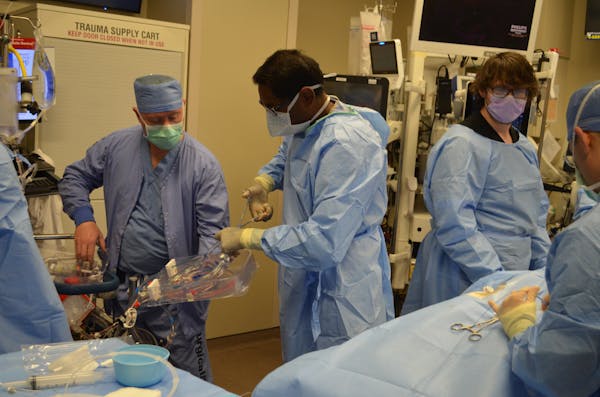Sudden cardiac arrest can happen to anyone, anytime, anywhere — and is almost always fatal.
Fewer than 12% of victims survive, according to the American Heart Association. The Plymouth Rotary Club is on a mission to improve those odds with an ambitious goal of training 10% of the residents in the west metro suburb how to spot symptoms and what to do.
For 11 years, the club has conducted free training sessions a few times a month through its Heart Safe Plymouth initiative. Attendance recently topped the 7,000 mark, but there is a need to educate even more people in the community of nearly 80,000, said Russ Carlson, a Rotary member and Heart Safe Plymouth co-chair.
"These are the people you want to have around," Carlson said, noting that having bystanders jump in before medical help arrives "is critical to that person surviving."
Sudden cardiac arrest — often confused with a heart attack — was thrust into the national spotlight this year when Buffalo Bills safety Damar Hamlin collapsed during a Monday night game. Hamlin recovered largely because he got prompt medical attention.
The Rotary Club wants to train volunteers who can render aid in places such as coffee shops, parks, schools, grocery stores and churches where medical personnel are not just feet away on the sidelines.
"We don't wait for help; we are the help," said lead trainer Norm Okerstrom. "We take the place of the heart."
Okerstrom's son, Teddy, was 16 when he went into cardiac arrest in 2009 while running sprints with his high school football team. Coaches performed CPR and used an automated external defibrillator (AED) to help save his life.
"This is why we are doing what we are doing," Okerstrom said. "Everybody should know CPR."
In 2022, the Plymouth Fire Department was called to 121 cases in which a victim needed CPR. But department first responders can't be everywhere, said Police Chief Erik Fadden.
"It would be a tall order to train that many people," Fadden said. "[Heart Safe Plymouth] makes the city a safer place for everybody. It's inspiring."
On a recent Thursday evening, about 20 participants learned the difference between a heart attack and cardiac arrest. With a heart attack, victims experience a blockage and exhibit symptoms such as sweating and chest pain but are often still coherent. Their heart continues to beat. CPR should not be performed, Okerstrom said.
With cardiac arrest, the victim loses consciousness, may turn blue and their heart stops, making CPR necessary, he said.
In 90 minutes, Okerstrom taught how to assess the situation and the proper actions to take. Participants practiced giving chest compressions using blow-up dummies that clicked if they pushed hard enough to push blood through the body.
In a real-life situation, "[the victim] won't click, but you will remember" to push 2 to 2.4 inches at a rate of 100 to 120 compressions a minute, Okerstrom said.
Attendees also learned to call 911, and how to hook up an AED to shock the heart back into rhythm.
"CPR plus AEDs saves lives," Okerstrom said.
Pat Mauch of Plymouth came to the class for the third time. She said she wanted to keep up on current CPR techniques in case she ever needed to use them.
"I hope to have the knowledge, be brave enough to put it into action and have the confidence to use it if I need to," Mauch said.
Kari Cinker, also of Plymouth, was attending for the first time.
"It's an important skill to have," she said. "I might be able to save someone's life. This was two hours well spent."
About 350,000 people experience cardiac arrest in the United States each year, the American Heart Association said. In Minnesota, cardiovascular events, including cardiac arrest, are the second-leading cause of death, responsible for nearly 20% of deaths, according to the Minnesota Department of Health.
Plymouth is one of scores of Minnesota cities that have earned a Heart Safe designation from the Health Department for efforts to prepare staff and residents to respond.
With 70 % of cardiac arrests happening at home, Okerstrom pleaded with attendees to send their spouses, neighbors and friends to the class.
"What I want in Plymouth is that we can give you the best chance possible of surviving," he said. "We want to have a save."
Carolyn Parnell, 'trailblazer' who served as Minnesota's first IT commissioner, dies




